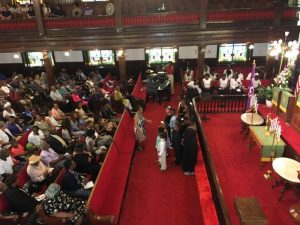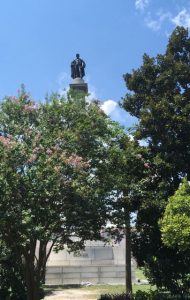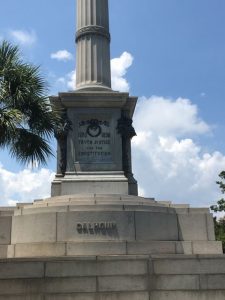Charleston became the biggest slave port in America, selling about half the Africans bought into the American colonies. There were many marked and unmarked antebellum and Civil War sites that we visited. From Liberty Square you can actually see Sullivan’s Island, where South Carolina’s African slaves were kept in pens after being taken off the ships that had brought them across the Atlantic.
After the Civil War there was a brief period of Reconstruction when Afro-Americans gained a measure of power. But as was true across the South this period was short lived, and Black Codes were put in place restricting movement and association, setting up rigid rules of racial segregation. Thousands of African Americans fled the state; whites became the majority. There were some protests and sit-ins during the Civil Rights movement and the AME churches were central to mass organization.
The Charleston church shooting was a mass shooting, that took place at the Emanuel African Methodist Episcopal Church in downtown Charleston, South Carolina, on the evening of June 17, 2015. During a prayer service, nine parishioners (including the senior pastor, state senator Clementa C. Pinckney) were killed by gunman Dylan Roof, a 21-year-old white supremacist. “The killer embraced white supremacist ideology and took pictures of himself with the Confederate flag” wrote Joanna Slater in her well researched and articulate Globe and Mail expose from earlier this summer.
The link for her piece that describes the “sea of change” that is under way in the American South and how they consider the future of their Confederate monuments is explained further here:
What I later learned was how Roof entered into the church by actually joining the bible study (where the parishioners were gathered) and took a source sheet with the various bible verses, sat with the victims for about 15 minutes and then, when they stood for prayers, pulled out a caliber pistol and fired 70 rounds at them. This, Roof claimed, was a race war.
So having the chance to attend Mother Emanuel church for a Sunday service was important, and hugely important to Ali, my new traveling partner, and Joanna’s brother.
Mother Emanuel church was very close to our bed & breakfast so we awoke quickly knowing that neither of us are great at being on time. Ali, like me, enjoys adventure, meeting new people and accessing unique experiences. So we hurried to make it to church on time.
We arrived at church with a warm welcome and we were each offered a hand held fan as well as a program and we were ushered upstairs to the gallery. The congregants were welcoming as they greeted us, and we were among the very few white faces at church that morning. The church was packed – there was hardly a spare seat in the house, and man it was hot. I was so impressed with the way the program/order of the service was structured, as it detailed the morning’s service, including the words of every hymn, and the interpretations of each of the chosen passages from the New Testament being read that week. What we both noticed (quite apparently) was that there was limited security at the front door. Unlike any synagogue in London, this church hardly had any police guarding the doors, though we did notice that the members of the church community were standing on guard inside the doors whilst the pastor spoke.
Before I explain the church service itself, it is important to just mention a thing or two about the history of this institution, as a place of resistance. It is not only the oldest AME (African Methodist Episcopal) church in the South, but between the years 1818 and 1822, Denmark Vesey, who was one of the church’s founders, held regular discussions to plot insurrection. Emanuel Church was burned in retaliation after Vesey’s attempted revolt and after it was rebuilt, worship continued in secret until 1865 (as all black churches had been outlawed in 1834).
The service was a frenzy of positive, musical and religious energy. The 5 piece band was frenetic, and the choir sang with furious harmony. The teenage girls performed a praise dance piece, and the children’s choir was led by a middle aged woman who could shake her hips better than anyone I know. Young girls read excerpts from the bible and were considered the young leaders of the community. I connected to that, and felt very proud of these young women.
There were many moments in the service that brought me to tears – and I was trying to figure out why. As we initially walked in, the first hymn was one of praise called “I will Bless Thee, O Lord”. The same chorus was repeated over and over again, each time with the pastor calling out if anyone had something they were thankful for, something they wanted to reach out to Jesus for, something they needed healing for. I sat there trying to get into the hearts and minds of these people. How can they keep fighting forward, deeply believing, when their lives have been knocked down so many times, and have been for so long? Where does their hope come from? From Jesus? From God? From community? From music?
Probably from all of the above.
And that was what it was that made me really cry – that once again, due to my white privilege, I have never had to suffer in the same way. I don’t have a recent past that would shatter my self-esteem, nor cause me to be in economic distress. I will never have the worry about being incarcerated unjustly, nor be spoken to in a rude way, just because of the colour of my skin. There was so much to be sad and mournful for. But the entire community was enraptured with the idea that Jesus will save them, will guide them, and will heal them. The parishioners often stood up whilst singing, or whilst the pastor was preaching, with their hands up to the sky, singing with such force and praying with such strength. I felt filled with humility.
A few days after the shooting, President Obama stood and eulogized Pastor Pinckney, and described Pickney’s empathy and gentleness. Obama described that Pinckney embraced the AME’s collective mission to feed the hungry, house the homeless – that he had a call and an imperative for a just society; and that he was a good man.
Obama spoke about the pain that the Confederate flag instilled in too many citizens. The flag represented more than ancestral pride, it represented oppression and systemic racial subjugation. A removal of that flag from the state symbol would directly communicate the message that the cause of slavery was wrong. And that the actuality of Jim Crow and the resistance to civil rights for all people was wrong. It would heal the wounds of many and the expression of the amazing changes that have transformed the USA for the better. Obama stated : “By taking down that flag, we are expressing God’s grace. But I don’t think God wants us to stop there. We have been blind to how past injustices shape the present. Perhaps this tragedy forces us to ask some tough questions. How can this poverty and lack of quality education continue? Perhaps we need to relook at how come our children continue to hate?”
You can watch Obama’s full eulogy here. He often speaks of grace, and the grace that God will continue to shine on the United States of American. And so Obama sings Amazing Grace, which is immensely moving (though you will have to wait until the end of the eulogy to hear it)
What can be considered Emanuel Church’s institutional opposite is also found down the road on the same Calhoun Street. Two monuments stand in the square a block away from the church. The first is the Citadel, which was built after Vesey’s uprising as a training ground for white militia to quell any future slave uprisings. And second is an imposing statue of South Carolina senator John C. Calhoun who, prior to the Civil War, was the leading advocate for slavery in the US Congress, defending it as a “positive good.”
I suppose the question is, where does this hate come from and why now? James sent me a Guardian article which is entitled: “The civil war lies on us like a sleeping dragon”: American’s deadly divide and why it has returned. Like Vesey’s uprising and the direct response to build a Citadel to train white men to overthrow slaves, America continues to be full of fear. If we look back to the first half of the 19th century, can we place ourselves there again, where rhetoric and real violence threatened communities so viscerally?
Later in the afternoon we visited the oldest synagogue in the United States called Kahal Kadosh Beth Elohim. When going through the volumes of books in the book shop, I found a book called the Jewish Confederates. I wanted to know what the position of Jews were to slavery in that time. For a brief moment, I wanted to believe that the Jewish community were exempt to slavery – that being slaves to Pharoah in Egypt was enough of a personal narrative to choose not to enslave African Americans. But no. They were slave owners too and even among pages and pages of explanation as to why they chose to keep slaves, I didn’t feel convinced.
We continued to look for Septima Clark, before devouring more southern delicious food – perhaps we also needed to find comfort after an immensely moving day.













